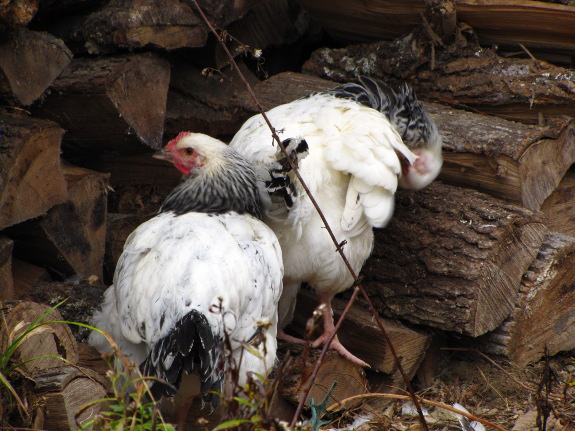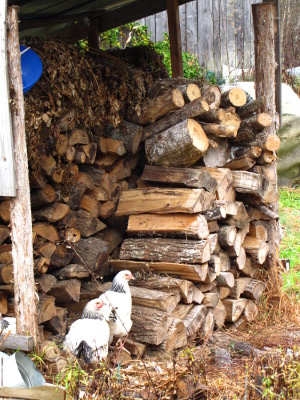
State of the wood shed in late November

The trickiest part of
homesteading is walking the tightrope between too little, enough, and
too much. When you get all of your food at the grocery store,
it's easy to just buy what you need, but how big should your summer
garden be if it's going to provide all of your winter food too?
I've just about figured out food, but am still learning how much
firewood we need for the winter.
 In a perfect world, you cut
your firewood a year in advance so that the wood dries and burns at
peak efficiency. We haven't quite achieved that goal yet, but we
have learned that there's little use in cutting firewood in our climate
once winter's damp sets in. So what we have in the wood shed now
needs to last until spring.
In a perfect world, you cut
your firewood a year in advance so that the wood dries and burns at
peak efficiency. We haven't quite achieved that goal yet, but we
have learned that there's little use in cutting firewood in our climate
once winter's damp sets in. So what we have in the wood shed now
needs to last until spring.
I've been burning wood
with great abandon over the last month, lighting a fire whenever I feel
like it even if we don't really need it. It's been a mostly warm
fall, but I've still had fires on about half the days this month,
usually just a fire in the morning or evening, not one that lasts all
day.
As you can see, we've
used up about two thirds of our first tier of wood, which wasn't
stacked quite as high as the other two and a half tiers. At this
rate, I suspect we might run low on wood late in the winter and have to
drive some wetter wood in from
the parking area. Hopefully next year I'll have a better idea
of how much firewood we need and can have it all under cover by the end
of the summer.
(As a side note, yes,
our young Light Sussex do think the wood shed is a much more fun spot
to hang out than the coop on a rainy November day.)
Want more in-depth information? Browse through our books.
Or explore more posts by date or by subject.
About us: Anna Hess and Mark Hamilton spent over a decade living self-sufficiently in the mountains of Virginia before moving north to start over from scratch in the foothills of Ohio. They've experimented with permaculture, no-till gardening, trailersteading, home-based microbusinesses and much more, writing about their adventures in both blogs and books.
Want to be notified when new comments are posted on this page? Click on the RSS button after you add a comment to subscribe to the comment feed, or simply check the box beside "email replies to me" while writing your comment.

I'm currently going through the same thing. Our new stove burns at a different rate than then old one, and the new house is two stories instead of one. It's tough for me to predict, but I'd say we're going to run short too. One thing I did was cut up some logs and stack them under the old goat barn roof so they would stay dry. That way I can at least continue splitting wood on nice days, and it can get a head start on curing even though it hasn't been split yet.
My brother said I should get a log splitter. But then I'd have to buy gas to power it, not to mention the upfront cost of buying one. And wood cutting would become a noxious, noisy affair instead of a peaceful one out in the clean air. And I'd have to buy a gym membership to help me get the exercise I could have had from chopping wood. Wouldn't it be easier to just chop it myself and skip the gym membership, cost of a wood splitter, and cost of gas to run it? This is a micro-example of the economic treadmill most of us find ourselves in these days. It is nice that something as simple, yet vital, as putting up wood for the winter can remind me of that treadmill and how happy I am to have taken it from level 8 to level 3. Now I can walk instead of run. Maybe someday I'll hop off completely.
Congrats again on your book deal. You and Mark have been and continue to be an inspiration for us. You set a standard that is high, yet attainable. Your blog posts provide valuable information instead of just updates (like ours lately), pretty pictures and rants. You DO more than you talk about doing. You walk the walk.
Oh, I was ranting. That's what happens when I comment after a cup of morning coffee.
I've got the stove running right now and boy am I glad for it's heat on this cold November day. But I don't have even a single cord cut, split or stacked. Worse, I let a very large maple lay on the ground for 2 years and now it's rotted to nothing useful. I do have some other wood laying around the lot that should give me about a cord of wood once I bob it, split it and stack it. In my mind, wood never really cures fully until it's been split and let sit for 2 years. I suppose the only good news I have in regards to my wood situation is that I've finally learned the use of a splitting axe so I don't have to buy that hydraulic wood splitter that I thought was an essential part of my life.
I should mention that I'm the opposite of you in regards to when I prefer to cut wood. Winter is my favorite time to cut wood. I don't sweat as much in the cold weather and all the poison ivy has died off.
You should be able to use the green wood when you have an established fire with coals you're going to keep going for hours, later in the winter. Folk wisdom says that green wood burns longer.
I've still only had 5 fires this fall; hope it gets cold enough for one today!
Everett --- I wish we were together enough to stack excess wood in the dry! We have some trees we've taken down, but never seem to have enough dry weather to haul the logs back to the house area.
You're totally right about the rat race treadmill. I'm so glad you're working your way free of it!
(And you're very nice to say we don't rant. I know I rant occasionally, but I do try to keep it down to no more than a couple of times a month... )
)
Phreak --- Yep, we've had wood sit out until it rotted too. Thus the impetus for our hugelkultur mounds! No biomass is ever wasted....
I've read others say that wood is only really cured after two years, and I suspect you're right. I have noticed that the longer we cure our wood, the faster it lights and the more heat it puts off. One of these days we'll get there! We'll need to build another woodshed, though, to have space to store two years' worth under cover.
Joey --- You can use green wood like that, but my understanding is that it really cuts down on efficiency --- more smoke and less heat as the fire works to evaporate the water before burning the wood. Of course, when I get desperate, my standards lower pretty quickly...
You and your underground house. Hmmph.
We are lucky to have amazingly dry winters here, but the summers are super humid. I have had the best luck building exploded cords with stabilizers built in. An exploded cord is a cord of wood with one foot gaps between tiers. This does make the whole thing unstable, so if you put a few long, wrist thick pieces that bridge one or two gaps, it really makes it stable without interfering with airflow. Then cover the stack with scrap plywood or corrugated roofing. We are burning Japanese cypress I split in late September, and it is dry enough to ring when you clap them (but the wood was not green cut though, it had been cut and left uncovered on the forest floor since last year).
This is how I estimate my wood needs:
fill the firewood rack next to our stove and count all the pieces
The next morning, I count what is left and subtract.
Multiply that by the number of days in an average heating season.
We burn an average of 30 pieces a day Our heating season is Nov-April- about 180 days. 30*180=5400 The size I split wood, one square foot has about 15 splits of wood on average (go and count a few random square feet on your pile), so that comes to 360 square feet of wood- about three cords (360/128=2.8)
I am considering building a solar wood drier (because while I talk the talk, I only have 2 cords split and stacked this season!)
And remember to stack wood bark side up!
Phreak --- Good point about the small stove problem. We tend to keep two kinds of wood on hand for our small stove --- a soft wood like box-elder or tulip-tree and a hardwood like oak. I've found that even if I let the coals go way down, if I toss on a bit of box-elder kindling, it flares right back up! Of course, then I have to work up through larger box-elder logs, smaller oak logs, and then finally back to large oak logs, which is probably what you meant....
Eric --- I remember seeing photos of your exploded cords on your blog and thinking they looked great! Too bad it's so darn wet here.
I think I'd complicate your formula a bit (but I like complicated formulas...) I'd probably make sure I measured the wood needs on an average day, and then count the first and last months as only half months since they're the shoulder season.
Of course, looking back at my post- I (again) made the mistake of saying squared when I should have used cubed.
Ummm.. complicated formulas- maybe you could make a spreadsheet.... need to add more variables...